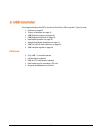32
Microprocessor Interface
The USB microprocessor interface is made up of a slave interface and a master interface.
The slave interface consists of a number of USB control and configuration registers.
USB internal registers can be accessed using a simple microprocessor interface.
The master interface is the integrated DMA controller that transfers packet data to and
from memory. The DMA controller facilitates USB endpoint data transfer efficiently,
while limiting microprocessor involvement.
Digital Phase Lock Loop Logic
The USB Digital Phase Lock Loop (DPLL) maintains a 12 MHz clock source that is locked to the
USB data steam. The DPLL requires a 48 MHz clock to 4x oversample the USB data stream
and detect transitions. These transitions are used to synthesize a nominally 12 MHz USB clock.
The DPLL also detects single-ended zeros, end-of-packet strobes, and NRZI decoding of the
serial data stream for the Rx Logic. All DPLL outputs are synchronized to the 12 MHz clock to
connect seamlessly to the USB core.
USB Hardware/Software Interface
The USB block combines hardware and software to efficiently implement USB target
applications. While the USB SIE handles the low-level USB Protocol Layer, the CPU handles
the higher level USB Device Framework, buffer management, and peripheral dependent
functions.
The hardware/software interface of the USB provides both a slave interface and a master
interface.
The slave interface consists of the Control Registers Block (CRB), which configure the
USB and provide status and interrupts to the microprocessor.
The master interface is the USB integrated DMA controller, which interrogates the
Buffer Descriptor Table (BDT), and transfers USB data to or from system memory. The
Buffer Descriptor Table (BDT) allows the microprocessor and USB to efficiently manage
multiple endpoints with very little CPU overhead.
Buffer Descriptor Table
The USB uses a Buffer Descriptor Table (BDT) in system memory to manage USB endpoint
communications efficiently. The BDT resides on a 256-byte boundary in system memory and is
pointed to by the BDT Page register.
Every endpoint direction requires two 4-byte Buffer Descriptor entries. Therefore, a system with
16 fully bidirectional endpoints requires 256 bytes of system memory to implement the BDT.
The two Buffer Descriptor (BD) entries allow for an EVEN BD and ODD BD entry for each
endpoint direction. This allows the microprocessor to process one BD while the USB processes
the other BD. Double buffering BDs in this way lets the USB easily transfer data at the
maximum throughput provided by USB.


















